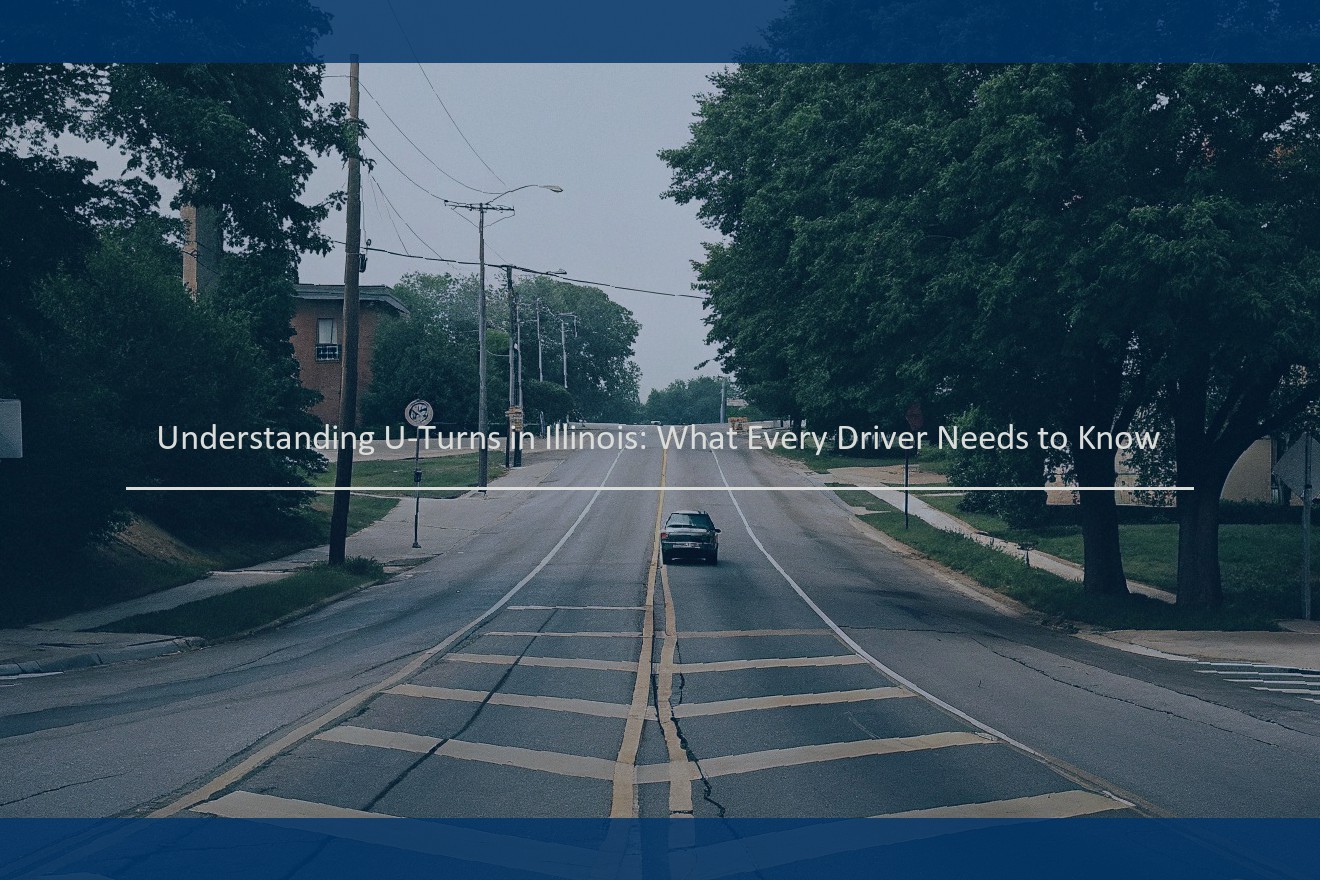An Overview of U-Turns in Illinois
In general, U-turns – the act of moving a vehicle from one side of the road to another by turning 180 degrees – are legal in Illinois unless specifically prohibited. That means that if you are on a four-lane road, for instance, and need to get onto the other side of a median or divider, you can make a U-turn almost anywhere unless a sign prohibits it. It is considered basic to pull a "U" when trying to turn around to get back to where you came from. On roads with more than one lane traveling in the same direction, you also can make a U-turn without concern – again unless there is a posted sign prohibiting the maneuver . We’ve all seen three-point turns (and five-point turns and other multi-point maneuvers) where a person gets into the oncoming lane of traffic, stops at oncoming vehicles waiting to go the opposite direction, and then makes the turn. Again, these are ill advised. A U-turn is almost always safer than a multi-point turn. There are two areas where U-turns are formally regulated on Illinois roads: Both areas are clearly marked but it is wise to know the local laws related to both – as in buying a local driving manual if necessary.

When You Can Make a U-Turn
U-turns are permitted in Illinois:
The Illinois Vehicle Code § 11-802, defines U-turn as "the term ‘u-turn’ means the turning of a vehicle so as to proceed in the opposite direction." The terms "turn" and "turning" are not defined in the code but they do not have a unique legal definition in a traffic related context. A "turn" is, at its essence, the act of changing direction. A "left turn" is defined under 625 ILCS 5/11-801 as "a turn toward the left hand side, lateral to the midline of the intersection" and a "right turn" as "a turn toward the right hand side, lateral to the midline of the intersection."
The Illinois Vehicle Code does not contain a specific provision dealing only with U-turns as there is for left turns and right turns. That should not deter one from believing that U-turns are illegal in Illinois. U-turns are expressly permitted in Illinois unless a law or sign prohibits it. § 11-802(b) permits U-turns "at intersections with or without signal lights." § 11-802(b) also permits U-turns "where no signs prohibiting them are erected."
There is a specific Illinois statutory provision that prohibits the use of U-turns in metropolitan counties of Cook, Du Page, Kane, Lake, Mc Henry, will and St. Clair. § 11-802(c) makes it illegal "to turn a vehicle so as to proceed in the opposite direction [in such metropolitan counties], except at intersections where no prohibition signs are posted."
Where U-Turns Are Not Allowed
In its efforts to keep the roads safe, the state of Illinois has determined certain locations where dangerous u-turns are likely to occur. According to the law, a u-turn is prohibited:
(a) Where signs are erected prohibiting such turns.
(b) Upon any curve or upon the approach to or near the crest of a hill, or at any place where the driver’s view is obstructed for a distance of 500 feet in either direction.
(c) At intersections where official signs or signals are posted prohibiting such turns.
(d) In any business district, except at intersections or designated locations where official signs prohibiting such turns are not posted.
Fines for Making an Illegal U-Turn
Making an illegal U-turn can have serious consequences beyond the immediate inconvenience of a traffic violation. In Illinois, drivers who violate U-turn laws can face a variety of penalties, including fines, points added to their driver’s record, and other legal repercussions. Depending on the severity of the violation, a driver who makes an illegal U-turn may receive a fine ranging from a standard traffic violation citation to a larger fine for more severe offenses that may also include appearing in court. This fine is just the first of several potential penalties for U-turns. An illegal U-turn can also lead to a driver receiving points on their driving record . For example, a standard illegal U-turn may result in three points being added to your record if you make the U-turn in the presence of oncoming traffic, create dangerous conditions for other drivers, cause an accident, or ignore posted signs prohibiting U-turns. However, if an illegal U-turn does not result in any additional issues, one point may be added to a driver’s record. The number of points on a driver’s record can directly impact their insurance premiums. Most auto insurance companies will raise rates for those who have too many points on their records, suggesting they are an inexperienced or unsafe driver. Insurance companies may also cancel a driver’s policy if they collect too many points. In addition to penalties assessed by the state government, a driver may also face legal action from aggrieved third parties, including pedestrians and other drivers.
U-Turn Safety
When it comes to making U-turns, the best way to avoid trouble is by keeping safety in mind and making decisions accordingly. While you can’t always control whether or not another driver violates the law or does something dangerous behind the wheel, you can do your part to safeguard your own safety and the safety of your passengers. If you are considering making a U-turn, our team of skilled Chicago car accident lawyers offers the following safety tips and recommendations: One of the best ways to reduce one’s risk of being involved in a U-turn accident is by simply obeying traffic laws and acting in accordance with the recommendations laid out in Section 11-804 of the Illinois Vehicle Code. That means that if you come across a "No U-Turn" sign (which is typically most commonly found at intersections and other busy roadways), you must follow the direction indicated by the sign. Just because you see a "permitted U-turn" sign does not mean driving in that direction is necessarily safe. Be sure to look for possible obstacles, including vehicles approaching from the other direction, cyclists, pedestrians, and so on, all of which could become hazards to your vehicle during the U-turn. You still need to be vigilant when making a U-turn at a location where the maneuver is permitted, looking for traffic approaching from all angles before initiating and while completing the maneuver. It is not unusual for drivers to ignore traffic laws and safety recommendations, even when they could protect their own safety as well as the safety of others. In fact, if the statistics are accurate, perhaps that’s not so surprising: according to the National Highway Traffic Safety Administration, in 2015 alone, an estimated 5,376 people in Illinois were injured or died in motor vehicle crashes that could have been prevented had the drivers violated only one rule of safe driving — traffic sign compliance/ right of way in intersections. Keep yourself and your passengers safe by using good judgment and making decisions in accordance with the law.
Commonly Asked Questions About U-Turns in Illinois
Q: Can I make a U-turn wherever I want in Illinois?
A: No, it is generally illegal to make a U-turn in areas where it is prohibited by law, such as at the crest of a hill, where your view is obstructed by railroad tracks, in a construction zone or within 500 feet of an intersection. Certain intersections, particularly those with large islands and three lanes, allow a U-turn where signs do not prohibit it.
Q: If I’m allowed to make a U-turn, when is it legal to do so?
A: You are prohibited from making a U-turn unless you can do so without impeding traffic , as these violations are considered failure to yield. U-turn violators can be charged with failure to yield a right-of-way, failure to use when appropriate or driving on the wrong side of the road. Some jurisdictions allow for U-turns only when a lane is provided, which would include a two-way left turn lane.
Q: I was injured in an accident caused by someone making an illegal U-turn. Is the driver at fault?
A: In Illinois, as long as you were following the rules of the road and obeying traffic laws, you would not be considered at fault unless you caused the accident.



+ There are no comments
Add yours